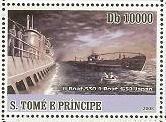|
Imperial Japanese Navy submarine I-52
 I-52, code-named Momi, Japanese for evergreen, was a Type C3 cargo submarine used during World War II for a secret mission to Lorient, France, then occupied by Germany, during which she was sunk. I-52, code-named Momi, Japanese for evergreen, was a Type C3 cargo submarine used during World War II for a secret mission to Lorient, France, then occupied by Germany, during which she was sunk.
She is also known as Japan`s "Golden Submarine", because she was carrying a cargo of gold to Germany as payment for war material and technology. Also interesting is that 800 kg of uranium oxide awaited I-52 for her return voyage at Lorient according to Ultra decrypts. It has been speculated that this was for the Japanese to develop a radiological weapon (a so-called "dirty bomb") for use against the United States.
US task force – and I-52’s fatal voyage
In March 1944, on her maiden voyage, I-52 departed Kure, Japan, picked up a cargo of 290 tons of strategic materials, including two tons of gold, in Singapore, and headed through the Indian Ocean to the Atlantic. In mid-ocean, she rendezvoused with the German U-530, a Type IXC/40 U-boat, which provided her with fuel and installed a Naxos radar detector. A Naxos operator and a navigator familiar with the Bay of Biscay joined the Japanese crew to help the submarine survive the final leg of the journey into Lorient. However, unknown to either the Japanese or the Germans, their codes had been broken and "Ultra" intercepts had revealed their plans; I-52 had been closely watched all the way from Singapore.
The escort carrier USS Bogue, enroute from Europe to the United States, was ordered to find and destroy the Japanese submarine. Arriving in the area of the meeting, the carrier began launching flights of Grumman Avenger torpedo bombers to search for the submarines. U-530 escaped undetected. I-52 did not.
At approximately 2340 on 23 June, Chief Ed Whitlock, the radar operator in Lieutenant Commander Jesse Taylor`s TBF Avenger, detected a surface contact. Taylor immediately dropped flares, illuminating the area, and attacked. After his first pass, he saw the depth bomb explosions just to starboard of the submarine, a near miss, and the boat diving. Taylor dropped a sonobouy, a newly-developed device that picked up underwater noise and transmitted it back to the aircraft carrier. Directed from the carrier according to the sonobouy`s signal, Taylor began a torpedo attack, dropping a Mark 24 "mine." That term was used for what was code-named "Fido": the first Allied acoustic torpedo, developed by the Harvard Underwater Sound Lab, which homed in on the sounds of the submarine. Fido was designed to be a "mission kill" weapon, it would damage the submarine so badly it would have to surface, rather than destroying it completely. Within minutes, the sonobouys transmitted the sounds of an explosion and mechanical break-up noises.
As Commander Taylor`s watch ended, the operators on Bogue and Taylor all thought he had sunk the sub. However, as Taylor`s patrol ended, he was relieved by Lieutenant (junior grade) William "Flash" Gordon, accompanied by civilian underwater sound expert Price Fish. They arrived on the scene just after midnight, and circled with Taylor for some time. At about 0100, Fish reported hearing some faint propeller noise in the area.
Captain A.B. Vosseller, commanding officer of Bogue, ordered a second attack; Gordon checked with Taylor about the exact position a sonobuoy and dropped another "Fido" where he believed the submarine to be. Taylor departed from the area at 0115, but Gordon stayed to circle the area and listen for any sign of activity but no further activity was reported.
Recent salvage operations
In late 1994, a salvage operation named Project Orca was launched to try and locate the I-52 and retrieve her valuable cargo of gold. Despite an extensive search, by March 1995 the search had proved to be a failure. Very shortly afterwards, however, in the spring of 1995 Paul Tidwell, working with the ocean exploration company Meridian Sciences, Inc. (later renamed Nauticos Corp.) located the wreck 5,240 meters deep, mostly upright. The vessel was found nearly 20 miles (32 km) from the datum quoted by the U.S. Navy at the time of the sinking. Her conning tower is intact and her hull number is still visible. The bow is broken up, probably due to impact on the bottom, and a large hole, undoubtedly caused by one of the torpedoes, is aft of the conning tower. Debris was scattered over a large area. Plans were made to raise the sub and recover the gold.
Specifications, Type C3:
The Type C3 was developed from the Type C1 and C2, with less powerful engines, fewer torpedo tubes, an extra main gun, and increased range. The reduction in installed power was due to difficulty of producing high-powered diesels in wartime.
At least some of these boats were later fitted with snorkels, and I-53 was also modified to carry six Kaiten. Seventeen further Type C3 units were cancelled, as were 25 units of a subsequent Type C4
Displacement (srf/sub tons): 2,564/3,644
Dimensions (L*B*D feet): 356`6*30`6*16`9
Propulsion: 2*2,350hp diesel engines, 2*600hp electric motors, 2 shafts
Speed (srf/sub knots): 17.5/6.5
Range (srf/sub n/miles@knots): 21,000@16/105@3
Diving depth (feet): 330
Complement: 94-101 officers and crew
Torpedo: 6*21" (533mm) bow torpedo tubes, total of 19 type 95 torpedoes
Mines: none
Armament: 2*140mm/50cal. Main deck gun, 2*25mm AA guns
Construction
Designed and built by Mitsubishi Corporation, between 1943 and 1944, as cargo carriers.
The Japanese constructed only three of these during World War II (I-52, I-53 and I-55), although twenty were planned. They were among the largest submarines ever built to date, and were known as the most advanced submarines of the period.
Back to History Index
 |
Saint Thomas |
2008 |
German U-Boat U-530 (type IX-40) and Japanese Submarine I-52 (type C-3 cargo sub`) |
|